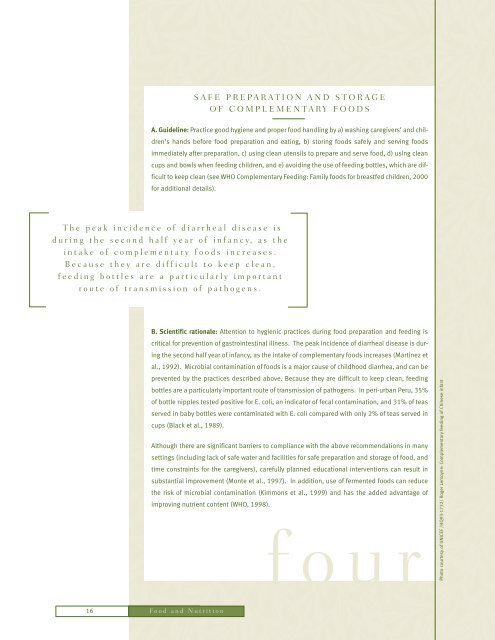Guiding Principles for Complementary Feeding of the Breastfed
Guiding Principles for Complementary Feeding of the Breastfed
Guiding Principles for Complementary Feeding of the Breastfed
Create successful ePaper yourself
Turn your PDF publications into a flip-book with our unique Google optimized e-Paper software.
SAFE PREPARATION AND STORAGE<br />
OF COMPLEMENTARY FOODS<br />
A. Guideline: Practice good hygiene and proper food handling by a) washing caregivers’ and children’s<br />
hands be<strong>for</strong>e food preparation and eating, b) storing foods safely and serving foods<br />
immediately after preparation, c) using clean utensils to prepare and serve food, d) using clean<br />
cups and bowls when feeding children, and e) avoiding <strong>the</strong> use <strong>of</strong> feeding bottles, which are difficult<br />
to keep clean (see WHO <strong>Complementary</strong> <strong>Feeding</strong>: Family foods <strong>for</strong> breastfed children, 2000<br />
<strong>for</strong> additional details).<br />
The peak incidence <strong>of</strong> diarrheal disease is<br />
during <strong>the</strong> second half year <strong>of</strong> infancy, as <strong>the</strong><br />
intake <strong>of</strong> complementary foods increases.<br />
Because <strong>the</strong>y are difficult to keep clean,<br />
feeding bottles are a particularly important<br />
route <strong>of</strong> transmission <strong>of</strong> pathogens.<br />
B. Scientific rationale: Attention to hygienic practices during food preparation and feeding is<br />
critical <strong>for</strong> prevention <strong>of</strong> gastrointestinal illness. The peak incidence <strong>of</strong> diarrheal disease is during<br />
<strong>the</strong> second half year <strong>of</strong> infancy, as <strong>the</strong> intake <strong>of</strong> complementary foods increases (Martinez et<br />
al., 1992). Microbial contamination <strong>of</strong> foods is a major cause <strong>of</strong> childhood diarrhea, and can be<br />
prevented by <strong>the</strong> practices described above. Because <strong>the</strong>y are difficult to keep clean, feeding<br />
bottles are a particularly important route <strong>of</strong> transmission <strong>of</strong> pathogens. In peri-urban Peru, 35%<br />
<strong>of</strong> bottle nipples tested positive <strong>for</strong> E. coli, an indicator <strong>of</strong> fecal contamination, and 31% <strong>of</strong> teas<br />
served in baby bottles were contaminated with E. coli compared with only 2% <strong>of</strong> teas served in<br />
cups (Black et al., 1989).<br />
Although <strong>the</strong>re are significant barriers to compliance with <strong>the</strong> above recommendations in many<br />
settings (including lack <strong>of</strong> safe water and facilities <strong>for</strong> safe preparation and storage <strong>of</strong> food, and<br />
time constraints <strong>for</strong> <strong>the</strong> caregivers), carefully planned educational interventions can result in<br />
substantial improvement (Monte et al., 1997). In addition, use <strong>of</strong> fermented foods can reduce<br />
<strong>the</strong> risk <strong>of</strong> microbial contamination (Kimmons et al., 1999) and has <strong>the</strong> added advantage <strong>of</strong><br />
improving nutrient content (WHO, 1998).<br />
16 Food and Nutrition four<br />
Photo courtesy <strong>of</strong> UNICEF /HQ93-1732/ Roger Lemoyne: <strong>Complementary</strong> feeding <strong>of</strong> Chinese infant

















